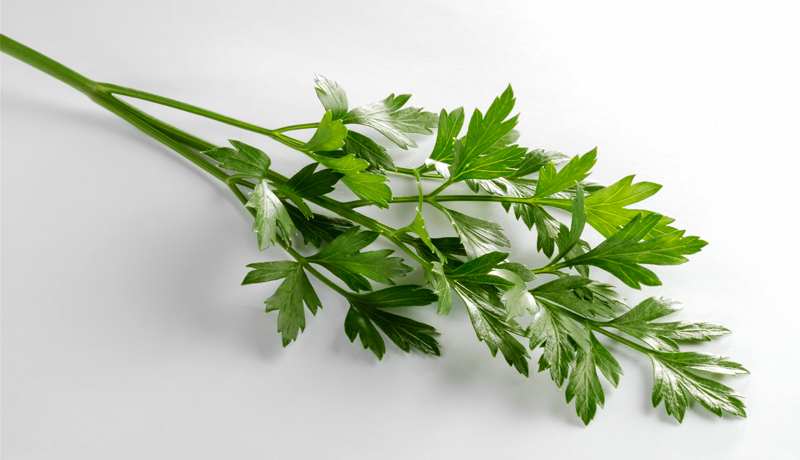by Sala Levin
The Passover seder is one of Judaism’s most simultaneously stable and mutable traditions: There are universally agreed-upon aspects of the ritual (the four questions, the bitter herb, the four cups of wine), and yet there are many variations. At some seders, attendees whip one another with scallions during Dayenu to mimic the lashings received by Jewish slaves; at others, celebrants act out Chad Gadya with hand puppets. Into this fray enters karpas, the green vegetable of the seder plate. Is it parsley? Celery? Raw onion? Carrot? Cooked potato? It could be any one of these.
The four questions famously ask, “On all other nights we dip only once; why on this night do we dip twice?” The first dipping is karpas, the vegetable dipped into salt water; the second is the bitter herb (maror) dipped into charoset. In the earliest seders, there wasn’t much that distinguished the first dipping from the second. “Well through the Middle Ages, the first dipping had no formal name and was simply called tibul rishon (first dipping), the act of dunking being the primary point,” writes the late Gil Marks in The Encyclopedia of Jewish Food.
What was dunked was, essentially, a matter of personal preference and what was regionally available. Amram Gaon, who compiled the basis of the now commonly accepted Haggadah in the 9th century, suggested using radish leaves, arugula, lettuce, parsley or cilantro. By the time Rabbi Joseph Caro wrote the seminal codification of Jewish law Shulchan Aruch around 1565, the vegetable course was known as karpas, which was Persian for “fine cotton” and first surfaced in a Jewish text in the Book of Esther, where it was used to describe wall hangings in the king’s palace. Though the word in Persian referred just to a kind of fabric, it may have been used in the Book of Esther to mean the color green. The Persian word karafs—not related to karpas—was used for both celery and parsley, a usage that likely transferred to Talmudic Hebrew.
Greenness was an important component of the vegetable, in keeping with the linguistic heritage of the word. But more essentially, karpas must be a vegetable that’s sanctified with the blessing for the fruit of the earth, generally recited over vegetables. Halachically, this blessing must be made on a vegetable eaten in its ideal form—in other words, a vegetable that is generally eaten raw must be served raw in order to receive the blessing, and a vegetable that is normally eaten cooked must be served cooked. A raw potato, for example, would not receive the fruit of the earth blessing. Likewise a boiled watermelon. Some debate whether parsley is really appropriate for karpas, given that it’s often cooked into dishes. “For this reason, my father uses parsley (as, supposedly, the literal meaning of karpas) with some cooked potato,” writes one commenter on an online message board. (The potato, along with turnips and white radishes, likely emerged as an option in northern Europe, where parsley and celery were rare; the justification for using these for the green vegetable is that their leaves are green.) Others even suggest using a banana, which, despite being a fruit, receives the fruit of the earth blessing.

The other crucial component of karpas is the substance into which it is dipped. Salt water is common among Ashkenazi Jews—many Sephardic Jews use vinegar—and both are widely believed to represent the tears Jewish slaves shed in Egypt. This, however, is a new idea, historically speaking. Traditionally, the dipping was more culinary than spiritual. “Originally this was a normal appetizer course, and over many centuries it devolved from a real appetizer to something totally symbolic and not particularly nourishing,” says Joshua Kulp, co-founder of the Conservative Yeshiva in Jerusalem and author of The Schechter Haggadah. “Normal people, when they come to your house, want to eat. Originally the seder really was like that—they’d eat a normal amount of food, a real appetizer course” in order to sustain themselves for the lengthy ceremony to follow.
Like other elements of the seder, karpas is nowadays often imbued with new meaning to make it relevant to today’s culture. In many ways, it’s one of the most naturally symbolic components of the seder—the green vegetable is an apt emblem of the renewal of springtime and the importance of the environment. In the Haggadah for Jews & Buddhists, attendees are urged to think of karpas as a reminder to “move beyond the narrow place in our thinking and seek creative solutions to the planet’s needs in order to survive and flourish.” The GLBT Passover Haggadah says of karpas, “At this season, when Mother Earth arrays herself new, the human spirit rises, and we renew our faith in a world where freedom and justice will prevail.” Other haggadahs are even more political. “Intellectual property laws make it possible for corporations to buy the rights to the genetic information contained within a plant, copyright the plant and seeds and then sell them back to indigenous people,” says the International Jewish Solidarity Network’s Liberation Seder Haggadah. “This is the theft of centuries of collective labor and wisdom.”
But not everyone takes karpas so seriously. Rob Corwin and Danny Jacobs, “cocktail enthusiasts” from San Francisco, have created The Sipping Seder, drinks inspired by elements of the seder. Made of gin, balsamic vinegar and parsley, the karpas concoction may not be kosher for Passover, strictly speaking, but it certainly elevates the humble herb.


I feel extremely cheerful to have seen your site page. I found the post beautiful and fascinating one. I am really extremely glad to visit your blog. Thanks for sharing your views.